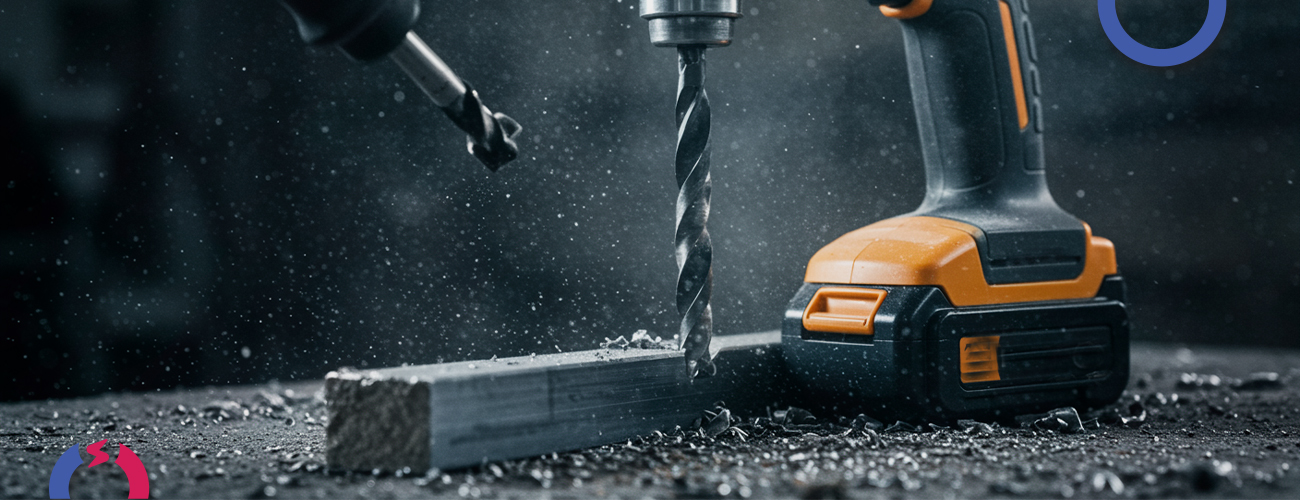Drilling is one of the most fundamental tasks in construction, woodworking, and various DIY projects. Having the right drilling tools is essential to ensure precision, efficiency, and safety. Whether you’re drilling into wood, metal, concrete, or masonry, the appropriate tool can make the task easier, faster, and more effective. In this blog, we will explore different types of drilling tools, their uses, and how to choose the right one for your project.
What Are Drilling Tools?
Drilling tools are equipment used to create holes in various materials. They include devices such as drills, drill bits, and accessories that make it possible to create holes with varying diameters and depths. The specific tool used depends on the material you’re drilling into and the type of hole required.
Types of Drilling Tools:
-
Cordless Drills: Cordless drills are among the most commonly used drilling tools, especially for household and light construction projects. Powered by rechargeable batteries, these drills provide flexibility and portability without the need for an electrical outlet. Cordless drills are great for drilling holes and driving screws into wood, plastic, or metal.
-
Hammer Drills: A hammer drill combines rotary drilling with a pulsating hammering action, making it suitable for drilling into harder materials like concrete, stone, or brick. The hammering action helps break through the surface, making it easier to drill into tough materials.
-
Impact Drills: Impact drills, or impact drivers, use a combination of rotational force and concussive force to drive screws into hard materials. They are generally more powerful than regular drills, making them ideal for heavy-duty tasks that involve driving long screws into wood, metal, or other dense materials.
-
Rotary Drills: Rotary drills are simple, powerful tools designed for drilling into a variety of materials, including wood, plastic, and metal. These drills use a rotating motion to bore through the material, and they often come with adjustable speed settings for different types of tasks.
-
Masonry Drills: Masonry drills are specialized drills designed to work with hard materials like brick, stone, and concrete. These drills typically feature a carbide tip and are designed to withstand the harshness of masonry work. Masonry drills can be used with a hammer drill or rotary drill for maximum efficiency.
-
Auger Drills: Auger drills are used for drilling deep, clean holes, especially in wood. They feature a long, spiral-shaped bit that allows them to bore deeper than most other drill bits. These drills are commonly used in woodworking and carpentry for tasks such as installing posts or creating holes for dowels.
-
Step Drills: Step drills are used to create holes with varying diameters. These drills are perfect for drilling holes in thin materials, such as sheet metal or plastic, and they allow for more precise control over the size of the hole.
-
Core Drills: Core drills are designed to remove a cylindrical core of material from the workpiece, leaving a clean, smooth hole behind. These drills are commonly used for drilling large holes in concrete or masonry and are particularly useful in construction and infrastructure projects.
-
Drill Press: A drill press is a stationary, powerful drill machine used for precise drilling tasks. It is ideal for drilling accurate holes at consistent depths and is often used in professional workshops for tasks requiring high precision.
How to Choose the Right Drilling Tool:
-
Material Type: The first factor to consider when choosing a drilling tool is the material you’ll be working with. For example, a hammer drill or masonry drill is essential when drilling into concrete or brick. For wood, a regular rotary drill or auger drill would be more suitable.
-
Hole Size: Depending on the size of the hole you need to create, you may need to use a specific type of drill bit or tool. Auger drills and step drills are ideal for creating large, deep holes, while smaller drills are better suited for precision work or smaller holes.
-
Power and Torque: For tougher materials like concrete and metal, you’ll need a drill with higher power and torque. Impact drills and hammer drills are ideal for heavy-duty tasks, while a standard rotary drill will work well for light or medium tasks.
-
Battery Life (For Cordless Drills): If you’re using a cordless drill, the battery life is crucial for uninterrupted work. Ensure that the drill you choose has a long-lasting battery, especially for large projects that require extended drilling time.
-
Speed Settings: Some drilling tools come with variable speed settings that allow you to adjust the speed based on the task at hand. Higher speeds are ideal for drilling through soft materials, while lower speeds work better for hard materials or precise tasks.
-
Ergonomics: Look for drills that are ergonomically designed to reduce strain on your hands and wrists. Features such as soft-grip handles and lightweight designs are important when working for extended periods.
Safety Tips When Using Drilling Tools:
-
Wear Protective Gear: Always wear safety glasses to protect your eyes from debris, as well as ear protection if you’re working in a noisy environment. Gloves are also recommended to protect your hands from vibration and sharp edges.
-
Secure the Material: Make sure the material you’re drilling into is securely clamped or held in place. Loose materials can move during drilling, which can be dangerous.
-
Check for Obstacles: Before drilling, ensure that there are no hidden wires, pipes, or other obstacles behind the surface you’re drilling into. Use a stud finder for walls or check blueprints to avoid damaging electrical or plumbing systems.
-
Proper Handling: Always hold the drill with both hands to ensure stability and prevent accidents. If using a drill press, lock the material securely in place to avoid it shifting.
-
Follow the Manufacturer’s Instructions: Every drill comes with specific guidelines and instructions from the manufacturer. Be sure to read them thoroughly to understand how to use the tool safely and effectively.
Maintenance Tips for Drilling Tools:
-
Clean After Use: After each use, clean your drilling tool to remove dust, debris, and any material buildup. This ensures the tool runs smoothly and remains in good condition for longer.
-
Sharpen Drill Bits: Regularly check and sharpen your drill bits. Dull bits can cause the drill to overheat and make the job more difficult. Sharpening your bits ensures smoother, more efficient drilling.
-
Lubricate Moving Parts: Keep the drill’s moving parts lubricated to prevent wear and tear. Lubrication also helps reduce friction, extending the tool’s life and improving performance.
-
Inspect for Wear: Check the tool and drill bits for signs of wear and tear, such as cracks or dullness. Replace worn-out parts to keep your tool functioning effectively.
-
Store Properly: Always store your drilling tools in a clean, dry place. Make sure the drill is kept in a secure location to prevent damage or accidental misuse.
Conclusion:
Drilling tools are indispensable in both professional and DIY work. Whether you’re building, repairing, or creating, choosing the right drilling tool for the job is essential to ensure the task is done effectively and safely. By selecting the right tool, considering key factors like material type and power, and following proper safety and maintenance guidelines, you can enhance both the quality of your work and the longevity of your tools.


